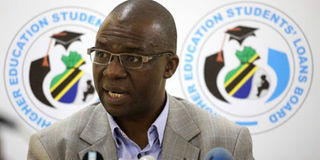HESLB now names scores of ‘defaulters’

HESLB Executive Director Abdul Razaq Badru.
What you need to know:
- Many of those whose names were published said they had finished repaying their loans.
- HELSB officials who spoke to The Citizen confirmed that hundreds of calls had been received from panicky former beneficiaries, who claimed that they owed the board nothing.
Dar es Salaam. There was confusion yesterday after the Higher Education Students Loans Board (HESLB) released the first batch of the names of defaulters who are required to repay their loans within 30 days.
Many of those whose names were published said they had finished repaying their loans.
HELSB officials who spoke to The Citizen confirmed that hundreds of calls had been received from panicky former beneficiaries, who claimed that they owed the board nothing.
Meanwhile, the HESLB website (www.heslb.go.tz), on which the names of 20,000 alleged defaulters were posted, had crashed by 11am after being overwhelmed by traffic.
On Monday, HESLB Executive Director Abdul Razaq Badru announced that the board would publish the names of 142,470 defaulters who owed the board a total of Sh239.3 billion in unpaid loans dating back to 1994. Only 81,055 former students are currently repaying their loans out of 379,179 beneficiaries. While some have finished repaying their loans, others are still enjoying the three-year grace period after graduating before they are slapped with loan bills.
Mr Badru said those would not repay their loans in full within 30 days would be prosecuted.
The list of defaulters, he added, included all graduates who took loans in 1994/95 when they were issued through the then Ministry of Higher Education.
Some of the beneficiaries who claimed to have finished repaying their loans told The Citizen yesterday that the publication of their names showed that HESLB’s database was not being regularly updated.
Speaking on condition of anonymity, a beneficiary who graduated from the University of Dar es Salaam (UDSM) in 2007 said that he began repaying the Sh3,637,480 he owed HESLB in 2012 after he was hired by a private firm in Dar es Salaam, and was shocked to see his name appear on the board’s website as a defaulter.
“The human resource manager of the firm I work with sent me this email (he shows it to The Citizen) to inform me that with effect from June 30, 2012 the company would have started to deduct eight per cent of my salary to repay the loan…here are the salary slips indicating the deductions, which went on for almost three years.
“The mistake I made is that I did not make a follow-up to confirm whether I had cleared the debt. The deductions stopped after three years and I relaxed, knowing that I had repaid the entire loan,” he said.
Another beneficiary, who graduated from UDSM in 2008, said he began repaying his loan in 2010 and had cleared the debt.
Reached for comment yesterday, Mr Badru said HESLB had been swamped with calls from people claiming to have finished repaying their loans, and urged all those whose names appeared on the list of defaulters to contact the board without delay.
Clarifying further on the confusion, Mr Badru said the HESLB database was up-to-date, and the board was able to identify all defaulters, “even those who owe one shilling”.
“If a person has a one-shilling arrear and has stopped repaying, he or she will be identified as a defaulter in the database,” he said, adding that those who had repaid their loans but did not submit the relevant documents to the board were also regarded as defaulters.
“We have been receiving a lot of complaints, which are sorted out when relevant documents are produced. In fact, we have some people who thought they had finished paying, but were slapped with penalties for late repayment,” he said.
Yesterday’s confusion came in the wake of a myriad of problems that have besieged the issuing of loans this academic year, with thousands of applicants missing out.
Reports indicate that over half of students admitted to pursue higher education for the year 2016/17 have yet to get loans, ostensibly because of “failure to meet requirements”.
At least 61,590 students were expected to begin studies in various universities last month, but only 24,000 were to get loans.
President John Magufuli last month said all new entrants and students who were continuing with their studies who met the requisite requirements would be provided with loans.
Speaking before laying the foundation stone for new UDSM hostels, he said the government had set aside Sh483 billion for higher education loans in 2016/17.
Various measures have been taken by the Ministry of Education, Science, Technology and Vocational Training to minimise the loss of money meant to be loaned to students pursuing higher education. These include recovering loans issued to “ghost” students.
The Minister of Education, Science, Technology and Vocational Training, Prof Joyce Ndalichako, in August ordered 31 universities to return Sh2.6 billion paid to 2,192 ghost students who had purportedly been enrolled in the institutions.
The announcement followed a joint investigation carried out earlier this year by HESLB and the Prevention and Combating of Corruption Bureau, which revealed that ShSh3.8 billion was paid to ghost students in the past.




